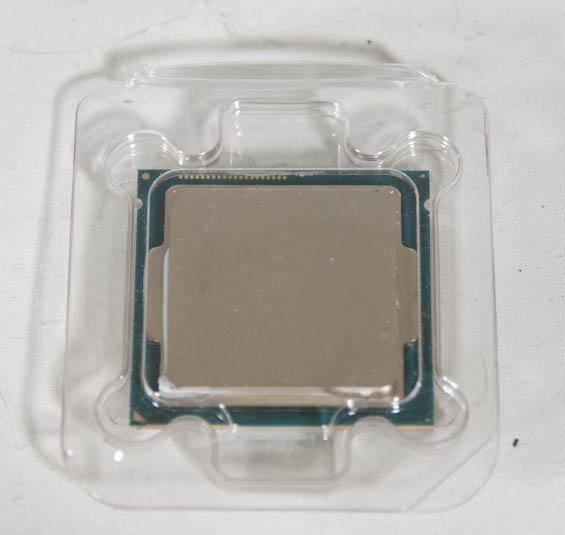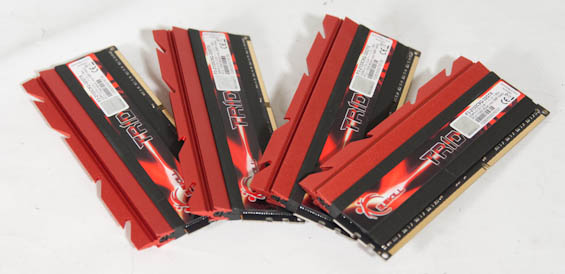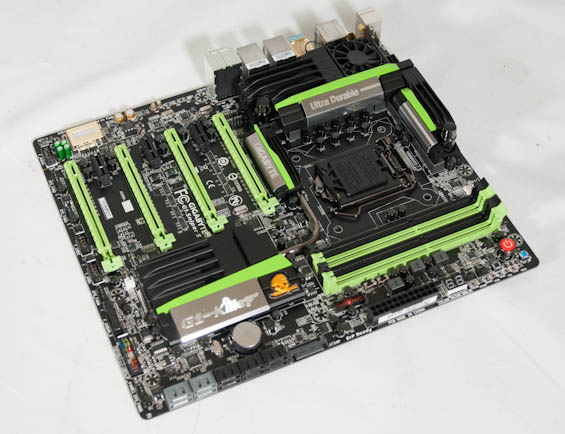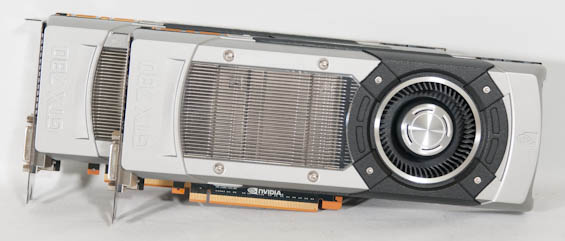The Neophyte's Custom Liquid Cooling Guide: How To, Why To, What To Expect
by Dustin Sklavos on September 30, 2013 12:01 AM ESTComponent selection for this build was tricky, but not overly so. If you're going to engage in an undertaking like this, you really do want to pick the most ideal hardware you can. Thankfully we had a few vendors willing to step up and donate some very high quality kit to this build.
Intel Core i7-4770K Processor

For our CPU we went with Intel's shiny new Haswell architecture in the form of the Core i7-4770K. This quad-core, hyper-threaded chip runs at a nominal 3.5GHz clock with a maximum turbo boost of 3.9GHz on a single core, and is one of Intel's first chips to feature an integrated VRM. Intel's 22nm chips seem to have been largely thermally limited, making the newest member of the family a compelling choice to be the center of a watercooling build. You do always run the risk of getting a dud CPU that simply doesn't want to run at a high clock speed without an unrealistic amount of voltage, though. Note that ours is a retail chip and not an Engineering Sample, so it's subject to the same potential limitations as any CPU you might pick up off the shelf.
Our thanks to CyberPowerPC for graciously donating this processor.
G.Skill Trident X 32GB (4x8GB) DDR3-2133 RAM

Our resident motherboard reviewer and overclocking expert, the good Dr. Ian Cutress, recommended we go with G.Skill for this build, and G.Skill was happy to oblige with a respectable kit of fast DDR3. This kit runs at a nominal 1600MHz, but features an XMP profile that sets it to run at 2133MHz with a CAS Latency of 9 at 1.6V. I'm not an aggressive memory overclocker, which makes the ready-out-of-the-box 2133MHz settings an easy way to score a little extra performance.
Our thanks to G.Skill for providing this memory.
Gigabyte G1.Sniper 5 Z87 Motherboard

I remain of the opinion that the Z87 chipset is arguably the most compelling part of Haswell, and Gigabyte's high end gaming offering hammers that home. The G1.Sniper 5 features a PLX switch enabling full PCIe 3.0 x16 lanes for each of two video cards, or PCIe 3.0 x8 for up to four. Alongside that are an additional four SATA 6Gbps ports to go along with the six that come with the Z87 chipset, dual gigabit ethernet NICs with one provided by Intel and the other courtesy of Killer Networks, and Creative Sound Core3D with a user upgradeable OP-AMP. There's even an 802.11n dual-band PCIe x1 wireless network adapter bundled with the motherboard.
But what sells this board for our purposes is that it includes not only active cooling on the motherboard's 16-phase power circuitry, but a liquid cooling path built in. There are barbs on both ends of the heatsink that allow you to include the power circuitry in your watercooling loop.
Our thanks to Gigabyte for providing this motherboard.
Dual NVIDIA GeForce GTX 780 Graphics Cards

With AMD currently still having issues with multi-GPU surround performance, we were left going to NVIDIA for a pair of high end graphics cards. Two GeForce GTX 770s would've been stellar on their own, but the 780 is getting a healthy reputation as being a decent overclocker in addition to just being a tremendously powerful card on its own. 7.1 billion transistors and 2,304 CUDA cores are nothing to sneeze at, and the 384-bit memory bus connected to 3GB of GDDR5 running at 6GHz stock ensures that beefy engine stays fed.
The biggest shame about using these reference 780s is actually having to remove their stock coolers. NVIDIA did a fantastic job engineering these shrouds, which are both very beautiful and very efficient.
Our thanks to NVIDIA for providing this pair of graphics cards.










106 Comments
View All Comments
cbgoding - Monday, September 30, 2013 - link
It's a PWM controlled pump that's advertised to be able to scale speeds with temperature. I'd say at least a few people do it. "Absolutely useless" is a bit of a stretch, you can have it barely spinning along at 1200 rpm at idle, and be able to really crank the pressure when it counts. Some blocks, notably all of Swiftech's CPU blocks, respond well to increased pressure due to their absurd internal pressure drop. Now if you were using a Raystorm or HF or something similar, no, just leave it at the lowest setting and forget it.mum1989 - Monday, September 30, 2013 - link
sorry, but i'ts a big fail ! :http://images.anandtech.com/graphs/graph7363/58372...
Noise levels are worse with Liquid Cooling.
ShieTar - Tuesday, October 1, 2013 - link
Yes. As anybody who ever built a liquid cooling system can explain to you, and as is clearly described in the article itself, the pump operation means that you always have a higher idle noise with a Liquid Cooling system.Not saying it can't be improved upon by picking a different pump, actively controlling it so it won't run at full speed all the time, and maybe placing it in a sound-damped compartment within your case.
Of course, the air flow setup looks excellent for the air cooling case, but far less than optimal for the liquid case. I mean, first off you have the two radiators basically in series, the top radiator will have to handle the air which has been already heated by the front radiator and additionally by the components within the case. That will be much less efficient than having 2 radiators in parallel, each with his own supply of fresh air. On top of that, there seems to be a rear exhaust fan installed which pulls out the same air pocket which the top radiator is trying to feed off. Given that the rear fan has no added resistance of a radiator, it will probably completely starve off the top radiator.
So yeah, I think a lot of steps could be improved about the setup described above, but calling it a "big fail" is just excessive. And most certainly, even the perfect water cooling setup will not show lower idle noises than the equally perfected air cooling system. Load: sure, Idle: never.
malkolm - Monday, September 30, 2013 - link
Nice article, thanks for the work and effort you put into this.As a few of the commenters here pointed out this is only one article with one cunclusion and one can easily find hundreds well written articles elsewhere.
I builded like ~100 custom-watercooled systems in the past 12 years as liquid cooling here in germany is by far more a topic than in the US. A reason for this might be that the sensitivity to noise and the corresponding need for a very silent (to absolutely inaudible!) consumer systems evolved earlier due to the lack of noisy air conditioning. Whatever...
What i want to point out is: Watercooling IS the only way to make a hardcore gaming system absolutely silent. The one i use atm consists of a i7-3930K and 2xGTX580 what maxes out to ~800Watts of thermal power while overclocked. So far i didn't figure out how it could be possible to cool such a monster reliable and very silent at the same time only with aircooling. I say its impossible, but maybe some might tell me how.
"Watercooling" itself is quite a lie, because in the end its again air that interacts as the media between the hot system on the one hand and the cool environment on the other. What the water in the watercooling really does is to overcome the limited spacial offering right inside the machine to actually cool. Esentially the water only transports the heat to a place where it can be cooled much more efficiently: To the border of your case or even out of it (using an external radiator).
Dustin you're right pointing out that you essentially have to add a pump to the system as a noise contributor when using watercooling, but you're wrong with the assumption that this automatically leads to additional noise. Of course youre screwed with a big pump like a laing D5, but there are a lot of pumps out there that are designed not to be heared in a completely silent environment.
Back ~15years as the whole pc watercooling stuff started people were looking for a decent pump. What they ended up with were waterpumps designed for aquaria in livingrooms. Esentially one of the best available waterpumps nowadays are (modded) waterpumps from Eheim: A specialist for aquaria ;)
Derivates from this (like the Aquacomputer Aquastream XT) can't be heard outside of the case. In a 0.5m distance apart my noisemeter shows 0.0sone , so i would call this inaudible.
As for the radiators, what you need ist area. The only thing better then lots of cooling area is...even more cooling area. As a rule of thumb systems i sell as silent have !at least! (100mm)² radiator area per 100 Watts of expected maximum thermal output.
Cooling area is the only real advantage of watercooling over conventional aircooling, so use it! For a conventional single CPU / single GPU configuration a few radiators mounted to your case are enough. For a system like you use here in this article i would strongly recommend an external radiator (like the Watercool MoRa3).
Considering these things (pump and area) everything else than what you found out and concluded would have been magic. If you REALLY want to go for silence one has to rebuild the cooling parts.
At the end a few sidenotes regarding watercooling:
-> watercooling helps save energy! each of my GTX580 uses about 40Watts less energy when used in my watercooled system (approx. 40-45°C GPU-temperature) than aircooled (80+°C). This more than makes up for the lousy ~5W needed for a waterpump.
-> You learn to allways cary a pipe wrench in your emergency bag for pc repairing;)
-> External cooling with an external radiator opens the field for put every(! except for optical drives if you need one) component with moveable parts away from your computer, your desk or even the same room. Once the tube system is completely filled one single small pump can drive meters of tube and many liters of water. In summer my radiator is planted outside my house in a shadowy corner so my room doesnt get heated by my computer at all.
malkolm - Monday, September 30, 2013 - link
Oh and what i forgot to mention and comes into my mind while reading the comments and complains about no fullcover parts for nvidia and so on:The hardware situation in the EU seems to be completely differnt from the US. Here we have plenty of companies in the small market of watercooling. A brief look at newegg forced me to post this link: http://www.aquatuning.de/index.php/language/en
Not for advertisement, but only to show some of you what you really CAN buy, provided you know where to look at it.
Death666Angel - Monday, September 30, 2013 - link
Phobya DC water pumps are also great, cheap-ish, powerful enough for most normal systems (CPU+ dual GPU), small and quiet. I would never use a Laing without some serious noise dampening involved.mapesdhs - Monday, September 30, 2013 - link
Given the level of experience you've referred to, I would be most interested if you could
write an article about these issues, covering the additional aspects of watercooled
builds you've mentioned which are not dealt with in the article, such as external units, etc.
As it happens, I'm in the process of building a 3930K setup with four 580s (for AE), only
air cooled atm, but I was thinking about switching to a watercooled config next year, mainly
for the GPUs (the enormous Phanteks cooler already does a good job of running the CPU
at 4.7). So, would you be up for writing some kind of article? I'd be happy to include it on
my site, full credit, etc., or maybe Anand would be interested?
Dustin has done a nice job of writing an introduction to this field, but there are always so
many more questions someone new to watercooling will want to ask. Starting off with a
closed loop kit isn't complicated (I've built two with H100s) but moving to a custom loop
can be rather daunting. The number of 'additional' relevant points made by numerous
posters shows just how broad this subject is.
Btw, re choice of CPU, once again I'm ever more convinced that a used 2700K is still
a better buy. :D Last one I bought (150 UKP on eBay) took mere minutes to get it
going at 5.0 with an old used Venomous-X on an ASUS M4E. Delidding is not for
the faint of heart...
Ian.
PS. A heartful thanks to all those posting comments! When it comes to sensible/useful
comments worth reading (as opposed to the usual CPU/GPU flame wars), this has to
be one of the best comment threads I've come across. Hmm, perhaps those who end
up meddling with watercooling are just more sensible in general? :)
mapesdhs - Monday, September 30, 2013 - link
NB: I was referring to malkolm.
cjs150 - Monday, September 30, 2013 - link
A few points about water-cooling1. It is fun. You get your hands dirty (or wet!) in actually building what you want not want the manufacturer wanted for the price.
2. It is not cheap.
3. Pick your case carefully, look at forums for what others have done.
4. A water cooled system is spot cooling: ie it cools only those spots where you have a water block. Air cooling is more general - as long as you have air movement you have a cooling effect. It is vital you have some air movement to cool things such as memory, hard drives.
5. Custom loops should be designed with both air bleeding and drainage in mind.
6. If you have a powerful GPU than a water cooled system will be a lot quieter than running on air.
7. A dremel is your friend !
willis936 - Monday, September 30, 2013 - link
Great article. It's a very rational look at things that are all too often romanticized. Everyone wants that 5GHz 4770k and a fancy water cooling kit but it's important to stop and ask yourself what you're really interested in. While I'd love to see an article analyzing everything about delidding from when it started, the myths, the logic, and of course lots and lots of testing, I doubt I'll ever see it done because it comes close to stepping on some political toes.Personally on air I could hit 4.2 @ 1.2v on a 4770k before running into thermal boundaries and a delid got me to 4.5 @ 1.3v with stress test temps in the 70s. To get to 4.6 stable I need literally at least 1.45v which results in thermal boundaries. Even if a delid with a custom water loop would keep that temp under control it's a long ways to go for a tiny bit. Money would be better spent on a binned chip that could hit 4.8 on air. That's the nature of the beast and thank you for addressing it and giving people a realistic look at what haswell OC is like. All of the reviews always talk about engineering samples which doesn't give a down to earth idea of what a retail sample will be like.